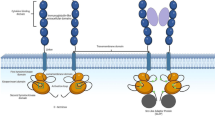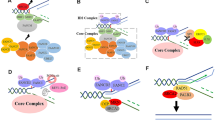Abstract
Human T-cell lymphotropic virus type 1 (HTLV-1) is the first identified human retrovirus responsible for two significant diseases: HTLV-1-associated myelopathy/tropical spastic paraparesis (HAM/TSP) and adult T-cell leukemia/lymphoma (ATLL). Although the majority of infected individuals remain asymptomatic carriers, a small percentage may develop ATLL or HAM/TSP. In tumorigenesis, a crucial process is angiogenesis, which involves the formation of new blood vessels. However, the precise mechanism of HTLV-1 associated angiogenesis remains unclear. This study aims to investigate the gene regulation involved in the angiogenesis signaling pathway associated with HTLV-1 infection. The research enrolled 20 male participants, including asymptomatic carriers and healthy individuals. Blood samples were collected and screened using ELISA for HTLV-1 confirmation, and PCR was performed for both Tax and HBZ for validation. RNA extraction and cDNA synthesis were carried out, followed by RT-qPCR analysis targeting cellular genes involved in angiogenesis. Our findings indicate that gene expression related to angiogenesis was elevated in HTLV-1 ACs patients. However, the differences in gene expression of the analyzed genes, including HSP27, Paxillin, PDK1, PTEN, RAF1, SOS1, and VEGFR2 between ACs and healthy individuals were not statistically significant. This suggests that although angiogenesis-related genes may show increased expression in HTLV-1 infection, they might not be robust indicators of ATLL progression in asymptomatic carriers. The results of our study demonstrate that angiogenesis gene expression is altered in ACs of HTLV-1, indicating potential involvement of angiogenesis in the early stages before ATLL development. While we observed elevated angiogenesis gene expression in ACs, the lack of statistical significance between ACs and healthy individuals suggests that these gene markers may not be sufficient on their own to predict the development of ATLL in asymptomatic carriers.

Similar content being viewed by others
Data availability
Data will be made available on reasonable request.
References
Poiesz BJ, Ruscetti FW, Gazdar AF, Bunn PA, Minna JD, Gallo RC. Detection and isolation of type C retrovirus particles from fresh and cultured lymphocytes of a patient with cutaneous T-cell lymphoma. Proc Natl Acad Sci USA. 1980;77(12):7415–9.
Poiesz BJ, Ruscetti FW, Reitz MS, Kalyanaraman VS, Gallo RC. Isolation of a new type C retrovirus (HTLV) in primary uncultured cells of a patient with Sezary T-cell leukaemia. Nature. 1981;294(5838):268–71.
Kalyanaraman VS, Sarngadharan MG, Robert-Guroff M, Miyoshi I, Golde D, Gallo RC. A new subtype of human T-cell leukemia virus (HTLV-II) associated with a T-cell variant of hairy cell leukemia. Science. 1982;218(4572):571–3.
Gallo RC. The discovery of the first human retrovirus: HTLV-1 and HTLV-2. Retrovirology. 2005;2(1):17.
Carneiro-Proietti ABF, Amaranto-Damasio M, Leal-Horiguchi C, Bastos R, Seabra-Freitas G, Borowiak D, et al. Mother-to-child transmission of human T-cell lymphotropic viruses-1/2: what we know, and what are the gaps in understanding and preventing this route of infection. J Pediat Infect Dis Soc. 2014;3(suppl_1):S24–9.
Brites C, Grassi MF, Quaresma JAS, Ishak R, Vallinoto ACR. Pathogenesis of HTLV-1 infection and progression biomarkers: an overview. Braz J Infect Dis. 2021;25(3): 101594.
Goncalves DU, Proietti FA, Ribas JG, Araujo MG, Pinheiro SR, Guedes AC, Carneiro-Proietti AB. Epidemiology, treatment, and prevention of human T-cell leukemia virus type 1-associated diseases. Clin Microbiol Rev. 2010;23(3):577–89.
Eusebio-Ponce E, Anguita E, Paulino-Ramirez R, Candel FJ. HTLV-1 infection: an emerging risk. Pathogenesis, epidemiology, diagnosis and associated diseases. Rev Esp Quimioter. 2019;32(6):485–96.
Willems L, Hasegawa H, Accolla R, Bangham C, Bazarbachi A, Bertazzoni U, et al. Reducing the global burden of HTLV-1 infection: an agenda for research and action. Antiviral Res. 2017;137:41–8.
Bangham CRM, Human T. Cell leukemia virus type 1: persistence and pathogenesis. Annu Rev Immunol. 2018;36:43–71.
Saito MJF. Association between HTLV-1 genotypes and risk of HAM/TSP. Front Microbiol. 2019;10:1101.
Iwanaga M, Watanabe T, Utsunomiya A, Okayama A, Uchimaru K, Koh KR, et al. Human T-cell leukemia virus type I (HTLV-1) proviral load and disease progression in asymptomatic HTLV-1 carriers: a nationwide prospective study in Japan. Blood. 2010;116(8):1211–9.
Bangham CRM, Matsuoka M. Human T-cell leukaemia virus type 1: parasitism and pathogenesis. Philos Trans R Soc Lond B Biol Sci. 2017;372(1732):20160272.
Zhang Y, Wang H, Oliveira RHM, Zhao C, Popel AS. Systems biology of angiogenesis signaling: computational models and omics. WIREs Mech Dis. 2022;14(4): e1550.
Logsdon EA, Finley SD, Popel AS, Mac GF. A systems biology view of blood vessel growth and remodelling. J Cell Mol Med. 2014;18(8):1491–508.
Flegg JA, Menon SN, Byrne HM, McElwain DLS. A current perspective on wound healing and tumour-induced angiogenesis. Bull Math Biol. 2020;82(2):23.
Semenza GL. Hypoxia-inducible factors in physiology and medicine. Cell. 2012;148(3):399–408.
Liu ZL, Chen HH, Zheng LL, Sun LP, Shi L. Angiogenic signaling pathways and anti-angiogenic therapy for cancer. Signal Transduct Target Ther. 2023;8(1):198.
Larionova I, Kazakova E, Gerashchenko T, Kzhyshkowska J. New angiogenic regulators produced by TAMs: perspective for targeting tumor angiogenesis. Cancers (Basel). 2021;13(13):3253.
Aspritoiu VM, Stoica I, Bleotu C, Diaconu CC. Epigenetic regulation of angiogenesis in development and tumors progression: potential implications for cancer treatment. Front Cell Dev Biol. 2021;9: 689962.
Mukwaya A, Jensen L, Lagali N. Relapse of pathological angiogenesis: functional role of the basement membrane and potential treatment strategies. Exp Mol Med. 2021;53(2):189–201.
El-Sabban ME, Merhi RA, Haidar HA, Arnulf B, Khoury H, Basbous J, et al. Human T-cell lymphotropic virus type 1-transformed cells induce angiogenesis and establish functional gap junctions with endothelial cells. Blood. 2002;99(9):3383–9.
Hoeben A, Landuyt B, Highley MS, Wildiers H, Van Oosterom AT, De Bruijn EA. Vascular endothelial growth factor and angiogenesis. Pharmacol Rev. 2004;56(4):549–80.
Shimizu Y, Yamanashi H, Miyata J, Takada M, Noguchi Y, Honda Y, et al. VEGF polymorphism rs3025039 and human T-Cell Leukemia Virus 1 (HTLV-1) infection among older Japanese individuals: a cross-sectional study. Bioengineering. 2022;9(10):527.
Schwab JD, Kühlwein SD, Ikonomi N, Kühl M, Kestler HAJC. Concepts in Boolean network modeling: What do they all mean? Comput Struct Biotechnol J. 2020;18:571–82.
Parmer T, Rocha LM, Radicchi F. Influence maximization in Boolean networks. Nat Commun. 2022;13(1):3457.
Weinstein N, Mendoza L, Gitler I, Klapp J. A network model to explore the effect of the micro-environment on endothelial cell behavior during angiogenesis. Front Physiol. 2017;8:960.
Bauer AL, Jackson TL, Jiang Y, Rohlf T. Receptor cross-talk in angiogenesis: mapping environmental cues to cell phenotype using a stochastic, Boolean signaling network model. J Theor Biol. 2010;264(3):838–46.
Jafari Nivlouei S, Soltani M, Carvalho J, Travasso R, Salimpour MR, Shirani E. Multiscale modeling of tumor growth and angiogenesis: evaluation of tumor-targeted therapy. PLoS Comput Biol. 2021;17(6): e1009081.
Zhong M, Li N, Qiu X, Ye Y, Chen H, Hua J, et al. TIPE regulates VEGFR2 expression and promotes angiogenesis in colorectal cancer. Int J Biol Sci. 2020;16(2):272–83.
Zimna A, Kurpisz M. Hypoxia-Inducible Factor-1 in physiological and pathophysiological angiogenesis: applications and therapies. Biomed Res Int. 2015;2015: 549412.
Khosravi Shahi P, Soria Lovelle A, Perez MG. Tumoral angiogenesis and breast cancer. Clin Transl Oncol. 2009;11(3):138–42.
Lampros M, Vlachos N, Voulgaris S, Alexiou GA. The role of Hsp27 in chemotherapy resistance. Biomedicines. 2022;10(4):897.
Evans IM, Britton G, Zachary IC. Vascular endothelial growth factor induces heat shock protein (HSP) 27 serine 82 phosphorylation and endothelial tubulogenesis via protein kinase D and independent of p38 kinase. Cell Signal. 2008;20(7):1375–84.
Lim SO, Park SG, Yoo JH, Park YM, Kim HJ, Jang KT, et al. Expression of heat shock proteins (HSP27, HSP60, HSP70, HSP90, GRP78, GRP94) in hepatitis B virus-related hepatocellular carcinomas and dysplastic nodules. World J Gastroenterol. 2005;11(14):2072–9.
Wainberg Z, Oliveira M, Lerner S, Tao Y, Brenner BG. Modulation of stress protein (hsp27 and hsp70) expression in CD4+ lymphocytic cells following acute infection with human immunodeficiency virus type-1. Virology. 1997;233(2):364–73.
Wartenberg M, Donmez F, Ling FC, Acker H, Hescheler J, Sauer H. Tumor-induced angiogenesis studied in confrontation cultures of multicellular tumor spheroids and embryoid bodies grown from pluripotent embryonic stem cells. FASEB J. 2001;15(6):995–1005.
German AE, Mammoto T, Jiang E, Ingber DE, Mammoto A. Paxillin controls endothelial cell migration and tumor angiogenesis by altering neuropilin 2 expression. J Cell Sci. 2014;127(8):1672–83.
Nogalski MT, Chan G, Stevenson EV, Gray S, Yurochko AD. Human cytomegalovirus-regulated paxillin in monocytes links cellular pathogenic motility to the process of viral entry. J Virol. 2011;85(3):1360–9.
Chen M-J, Wu D-W, Shen C-J, Cheng Y-M, Wu C-C, Lee H. Hepatitis B virus X protein promotes tumor invasion and poor prognosis in hepatocellular carcinoma via phosphorylation of paxillin at Serine 178 by activation of the c-Jun NH2-terminal kinase. Am J Cancer Res. 2020;10(1):275.
Yang WJ, Yan JB, Zhang L, Zhao F, Mei ZM, Yang YN, et al. Paxillin promotes the migration and angiogenesis of HUVECs and affects angiogenesis in the mouse cornea. Exp Ther Med. 2020;20(2):901–9.
Li C, Lin C, Cong X, Jiang Y. PDK1-WNK1 signaling is affected by HBx and involved in the viability and metastasis of hepatic cells. Oncol Lett. 2018;15(4):5940–6.
Lian S, Shao Y, Liu H, He J, Lu W, Zhang Y, et al. PDK1 induces JunB, EMT, cell migration and invasion in human gallbladder cancer. Oncotarget. 2015;6(30):29076–86.
Jiang BH, Liu LZ. PI3K/PTEN signaling in angiogenesis and tumorigenesis. Adv Cancer Res. 2009;102:19–65.
Wen S, Stolarov J, Myers MP, Su JD, Wigler MH, Tonks NK, Durden DL. PTEN controls tumor-induced angiogenesis. Proc Natl Acad Sci. 2001;98(8):4622–7.
Tian T, Nan K-J, Wang S-H, Liang X, Lu C-X, Guo H, et al. PTEN regulates angiogenesis and VEGF expression through phosphatase-dependent and-independent mechanisms in HepG2 cells. Carcinogenesis. 2010;31(7):1211–9.
Asami Y, Kakeya H, Komi Y, Kojima S, Nishikawa K, Beebe K, et al. Azaspirene, a fungal product, inhibits angiogenesis by blocking Raf-1 activation. Cancer Sci. 2008;99(9):1853–8.
Meng F, Ding J, Liu N, Zhang J, Shao X, Shen H, et al. Inhibition of gastric cancer angiogenesis by vector-based RNA interference for Raf-1. Cancer Biol Ther. 2005;4(1):113–7.
Hagan S, Al-Mulla F, Mallon E, Oien K, Ferrier R, Gusterson B, et al. Reduction of Raf-1 kinase inhibitor protein expression correlates with breast cancer metastasis. Clin Cancer Res. 2005;11(20):7392–7.
Mitsuda Y, Morita K, Kashiwazaki G, Taniguchi J, Bando T, Obara M, et al. RUNX1 positively regulates the ErbB2/HER2 signaling pathway through modulating SOS1 expression in gastric cancer cells. Sci Rep. 2018;8(1):6423.
Xing F, Zhao D, Wu S-Y, Tyagi A, Wu K, Sharma S, et al. Epigenetic and posttranscriptional modulation of SOS1 can promote breast cancer metastasis through obesity-activated c-met signaling in african-American women. Can Res. 2021;81(11):3008–21.
Ferrara N. VEGF and the quest for tumour angiogenesis factors. Nat Rev Cancer. 2002;2(10):795–803.
Kopparapu PK, Boorjian SA, Robinson BD, Downes M, Gudas LJ, Mongan NP, Persson JL. Expression of VEGF and its receptors VEGFR1/VEGFR2 is associated with invasiveness of bladder cancer. Anticancer Res. 2013;33(6):2381–90.
Yan JD, Liu Y, Zhang ZY, Liu GY, Xu JH, Liu LY, Hu YM. Expression and prognostic significance of VEGFR-2 in breast cancer. Pathol Res Pract. 2015;211(7):539–43.
Toro AU, Shukla SK, Bansal P. Emerging role of MicroRNA-based theranostics in hepatocellular carcinoma. Mol Biol Rep. 2023;50(9):7681–91.
Toro AU, Shukla SK, Bansal P. Micronome revealed miR-205-5p as key regulator of VEGFA during cancer related angiogenesis in hepatocellular carcinoma. Mol Biotechnol. 2023;65(7):1178–86.
Funding
This study was supported by Alborz University of Medical Sciences (Grant ID: 99-4275).
Author information
Authors and Affiliations
Corresponding authors
Ethics declarations
Conflict of interest
The authors declare that they have no conflict of interest.
Ethical consideration
This study was approved by Alborz University of Medical Sciences Ethics committee (IR.ABZUMS.REC.1400.056).
Additional information
Publisher's Note
Springer Nature remains neutral with regard to jurisdictional claims in published maps and institutional affiliations.
Rights and permissions
Springer Nature or its licensor (e.g. a society or other partner) holds exclusive rights to this article under a publishing agreement with the author(s) or other rightsholder(s); author self-archiving of the accepted manuscript version of this article is solely governed by the terms of such publishing agreement and applicable law.
About this article
Cite this article
Letafati, A., Mozhgani, SH., Marjani, A. et al. Decoding dysregulated angiogenesis in HTLV-1 asymptomatic carriers compared to healthy individuals. Med Oncol 40, 317 (2023). https://doi.org/10.1007/s12032-023-02177-5
Received:
Accepted:
Published:
DOI: https://doi.org/10.1007/s12032-023-02177-5




